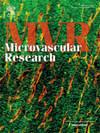带电极-骨骼肌电刺激对健康青年腓肠肌微血管反应性的急性影响
IF 2.7
4区 医学
Q2 PERIPHERAL VASCULAR DISEASE
引用次数: 0
摘要
目的:带状电极-骨骼肌电刺激(B-SES)可以提高肌肉力量、质量和运动耐受性。然而,其对骨骼肌微血管反应性的影响尚不清楚。在这项研究中,我们调查了单次B-SES对健康年轻男性腓肠肌微血管反应性的急性影响。方法在这项随机交叉研究中,12名健康年轻男性(平均年龄:20.8±1.0岁)接受了两种20分钟的条件:感觉阈值电刺激(Sham, n = 12)和不引起不适的最大强度电刺激(B-SES, n = 12)。采用近红外光谱和血管闭塞试验评估腓肠肌代谢率(组织氧饱和度[StO2]下坡)和微血管再灌注率(StO2上坡)。结果在B-SES条件下,StO2下坡明显变陡(Pre:−0.15±0.03%·s−1,Post:−0.20±0.03%·s−1,p = 0.002)。StO2上坡也显著变陡(Pre: 1.58±0.52%·s−1,Post: 2.56±0.71%·s−1,p <;0.001)。StO2下坡与StO2上坡呈显著负相关(r = - 0.581, p = 0.047)。假手术组未见明显变化。结论下肢单次B-SES治疗可显著提高腓肠肌代谢率,微血管再灌注增强。这些发现表明,B-SES可能是改善微血管反应性的有效治疗方法,特别是对于运动能力有限的个体。本文章由计算机程序翻译,如有差异,请以英文原文为准。
Acute effects of belt electrode-skeletal muscle electrical stimulation on microvascular responsiveness of the gastrocnemius muscle in healthy young men
Purpose
Belt electrode-skeletal muscle electrical stimulation (B-SES) improves muscle strength, mass, and exercise tolerance. However, its effects on skeletal muscle microvascular responsiveness remain unclear. In this study, we investigated the acute effects of a single B-SES session on gastrocnemius microvascular responsiveness in healthy young men.
Methods
In this randomized crossover study, 12 healthy young men (mean age: 20.8 ± 1.0 years) underwent two 20-min conditions: electrical stimulation at the sensory threshold (Sham, n = 12) and at the maximum intensity not causing discomfort (B-SES, n = 12). Gastrocnemius metabolic rate (tissue oxygen saturation [StO2] downslope) and microvascular reperfusion rate (StO2 upslope) were assessed using near-infrared spectroscopy and a vascular occlusion test.
Results
In the B-SES condition, the StO2 downslope significantly steepened (Pre: −0.15 ± 0.03 %·s−1, Post: −0.20 ± 0.03 %·s−1, p = 0.002). The StO2 upslope also significantly steepened (Pre: 1.58 ± 0.52 %·s−1, Post: 2.56 ± 0.71 %·s−1, p < 0.001). A significant negative correlation was observed between the StO2 downslope and StO2 upslope (r = −0.581, p = 0.047). No significant changes were observed in the Sham condition.
Conclusions
A single B-SES session applied to the lower extremity significantly increased gastrocnemius metabolic rate and was associated with enhanced microvascular reperfusion. These findings suggest B-SES may be a useful therapeutic approach to improving microvascular responsiveness, particularly in individuals with limited exercise capacity.
求助全文
通过发布文献求助,成功后即可免费获取论文全文。
去求助
来源期刊

Microvascular research
医学-外周血管病
CiteScore
6.00
自引率
3.20%
发文量
158
审稿时长
43 days
期刊介绍:
Microvascular Research is dedicated to the dissemination of fundamental information related to the microvascular field. Full-length articles presenting the results of original research and brief communications are featured.
Research Areas include:
• Angiogenesis
• Biochemistry
• Bioengineering
• Biomathematics
• Biophysics
• Cancer
• Circulatory homeostasis
• Comparative physiology
• Drug delivery
• Neuropharmacology
• Microvascular pathology
• Rheology
• Tissue Engineering.
 求助内容:
求助内容: 应助结果提醒方式:
应助结果提醒方式:


